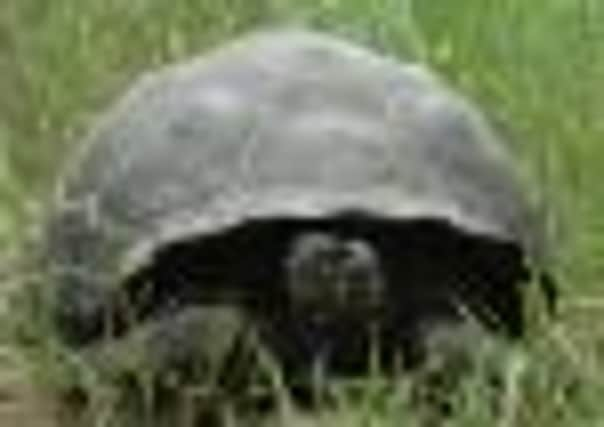Battling the slow decline of ancient breed


When the world-famous giant tortoise Lonesome George died this year it made headlines across the entire world.
The 100-year-old animal’s death drew the spotlight to the species and the Galapagos Islands, where they made their home in dwindling numbers.
Advertisement
Hide AdAdvertisement
Hide AdThe islands may be on the other side of the world to Yorkshire, but one of the region’s tour guides is playing a pivotal role in helping to protect the tortoises.
Santiago Bejarano, who works in Beverley, has donated weighing scales to help conservationists rear new giant tortoises in the Ecuadorian archipelago.
Giant tortoise populations in the Galapagos remain fragile after the death of Lonesome George, who was the last representative of his particular subspecies.
Named for the fact that he was the only one left of his kind, Lonesome George was not particularly old for a species that can live 200 years and, despite concerted efforts, conservationists had never been able to breed from him.
Advertisement
Hide AdAdvertisement
Hide AdHis death and the consequent extinction of his subspecies became a symbol of biodiversity loss the world over and his legacy continues to inspire environmentalists to restore Galapagos habitats.
Santiago Bejarano, who organises trips from his travel company, Think Galapagos on Trinity Lane, Beverley, to the Pacific archipelago, will deliver two highly-sensitive weighing scales to the Galapagos National Park in person on this weekend.
Since Lonesome George’s death, staff at the environmental institution have redoubled efforts to protect populations of the 10 remaining subspecies of giant tortoise.
The specialist scales will help them to monitor embryo growth of these precious creatures through their eggshells before returning them to the wild.
Advertisement
Hide AdAdvertisement
Hide Ad“The death of Lonesome George and extinction of his subspecies is a tragic reminder of just how fragile the ecosystem of the Galapagos is,” Mr Bejarano said.
“My life’s work is to share this magic with people and to help in the fight to conserve the flora and fauna for future generations.
“I hope that our donation to the tortoise rearing centre will help in some small way to preserve the future of these magnificent creatures.”
In addition to the Galapagos Islands, giant tortoises also make their homes on the Seychelles and Mascarenes.
Advertisement
Hide AdAdvertisement
Hide AdThe species has existed on the planet for more than 80 million years, their numbers have declined in recent centuries after being targeted for their meat by sailors.
For those keen to follow up on his work, there will be an opportunity next month.
Mr Bejarano will be talking about his visit to the giant tortoise conservation headquarters at The Robert Fuller Gallery in Thixendale on December 2.
Originally from Ecuador himself, Mr Bejarano is a recognised authority on the natural history of these remarkable islands.
Advertisement
Hide AdAdvertisement
Hide AdHe will also discuss a planned joint trip to Galapagos that will be led by himself and the wildlife artist and Country Week columnist Robert E Fuller in May 2014.
A recognised authority on wildlife, Robert E Fuller also leads wildlife spotting tours around the globe and brings the unique perspective of an artist to his trips.
Tickets for the joint talk, which takes place at 7.30pm on December 2nd at The Robert Fuller Gallery, Fotherdale Farm, Thixendale, cost £10.
To book contact The Robert Fuller Gallery on 01759 368355 www.robertefuller.com